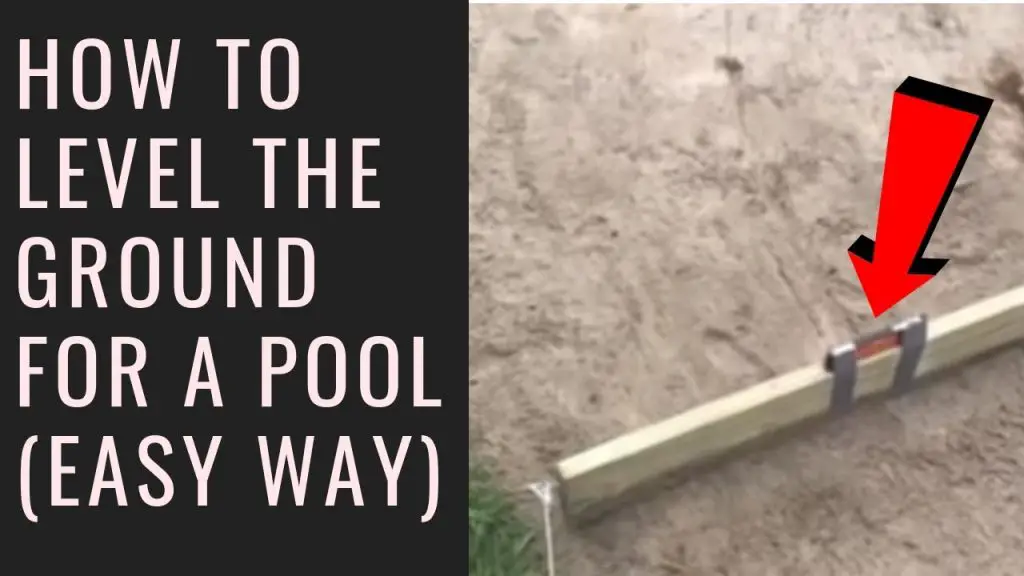Leveling the ground for a pool involves removing any obstructions and using a leveling tool to ensure a flat surface. To achieve this, start by identifying the area where the pool will be placed and clearing it of any debris or plants.
Next, use a shovel to remove any high spots and fill in any low spots with topsoil. After that, use a leveling tool, such as a long board or a laser level, to check for unevenness and make adjustments as needed.
Finally, compact the soil to create a firm base for the pool.
Assessment And Planning
Assessment and Planning play a crucial role in the process of leveling ground for a pool. Before diving into the physical work, a thorough analysis and thoughtful consideration are necessary to ensure a successful and stable pool installation. In this phase, you’ll need to evaluate the slope of the area and carefully decide on the pool location to determine the best course of action.
Checking The Slope Of The Area
Begin by assessing the gradient of the ground where the pool will be installed. Use a builder’s level or a transit to measure the elevation changes across the area. Establish whether the slope is within the acceptable limit for pool installation, typically not exceeding a 1-inch variance for every 10 feet. If the slope is too steep, it may require extensive grading or retaining walls to level the ground adequately.
Deciding On The Pool Location
Select an ideal spot for the pool by considering factors such as sunlight exposure, proximity to the house, and the overall landscape. Ensure that the selected area meets local building codes and zoning regulations. Avoid placing the pool in low-lying areas that are prone to flooding, as this could lead to drainage issues in the future. A well-considered choice for the pool location will contribute to a more enjoyable and functional swimming experience.

Credit: www.troublefreepool.com
Tools And Materials
When it comes to leveling the ground for your pool, having the right tools and materials is crucial for a successful and hassle-free process. From essential equipment to selecting the right materials, this guide will provide you with the information you need to ensure a smooth leveling process for your pool installation.
Essential Equipment Needed
Before starting the ground leveling process, make sure you have the essential equipment at hand. These tools will help you effectively level the ground and create a stable base for your pool:
- Shovel
- Rake
- Tape Measure
- Leveling Tool (such as a hand level or laser level)
- Wheelbarrow
- Compactor or Tamper
Selecting The Right Materials
Choosing the right materials for leveling the ground is crucial for the overall stability and longevity of your pool. Here are the materials you’ll need:
- Topsoil or Fill Dirt
- Gravel or Sand
- PVC Pipes (for drainage if needed)
Preparing The Site
Preparing the site for your pool is crucial to ensure a smooth installation process and a level and stable base for your pool. This step cannot be overlooked as it lays the foundation for your pool’s stability and longevity. In this section, we will cover the essential steps involved in preparing the site for your pool installation.
Clearing The Area
Before you can start leveling the ground for your pool, it is important to clear the area of any debris, trees, rocks, or plants that might interfere with the installation process. Make sure to remove any underground wires, pipes, or utilities that may be hidden beneath the ground surface. Clearing the area will also prevent any potential damage to your pool in the future. Take the time to thoroughly clean the site to create a blank canvas for your pool installation.
Marking The Perimeter
Once the area is cleared, the next step is to mark the perimeter of your pool. This will help you visualize the exact location and size of the pool, ensuring accuracy during the leveling process. Using stakes and string, mark the boundaries of your pool’s perimeter. Ensure that the stakes are firmly secured in the ground and the string is taut. This will serve as a guide for leveling the ground and ensure that the pool is aligned properly.
If your pool has a rectangular shape, use a measuring tape to verify that the marked dimensions are correct. Double-checking the measurements will help avoid any discrepancies before proceeding to the leveling process.
In addition to marking the perimeter, consider marking any additional features such as walkways or landscaping areas around the pool. This will provide a comprehensive view of the pool’s surroundings and aid in the overall planning of your pool project.
Now that the area is cleared and the perimeter is marked, you are ready to move on to the next crucial step of leveling the ground for your pool installation. Stay tuned for the next section, where we will delve into the process of grading and leveling the ground.

Credit: www.reddit.com
Excavation Process
Leveling the ground for a pool starts with excavating the area to ensure a smooth base. The excavation process involves removing soil and debris to create a stable foundation for the pool installation, allowing for proper water drainage and support.
Proper excavation is crucial for the overall safety and longevity of the pool structure.
Excavating The Ground
To start the leveling process for your pool, the first step is excavation. This involves removing the top layer of soil and creating a designated area for your pool. It is crucial to approach this task with precision and caution to ensure a stable foundation for your pool. Here’s a step-by-step guide on how to excavate the ground.Monitoring Depth And Slope
1. Determining the Depth
Before you begin digging, it’s important to determine the desired depth for your pool. Take into account the pool’s dimensions and the required depth for comfortable swimming. This will depend on the pool type, whether it is an above-ground or an in-ground pool, so consider these factors when assessing the depth.2. Marking the Slope
Once the depth is decided, it’s time to mark the desired slope. A proper slope ensures proper drainage and prevents water buildup. The slope should direct away from the pool area to avoid any potential flooding or damage. Use stakes and strings to establish the slope measurements accurately.3. Using Machinery
To simplify the excavation process, machinery like an excavator or a backhoe can be employed. These machines are efficient in removing large amounts of soil quickly. Ensure the equipment is operated by a skilled professional who can maneuver it safely and accurately according to the marked depth and slope.4. Manual Excavation
In some cases, manual excavation may be necessary, especially in areas where machinery cannot access easily. Using tools like shovels, spades, and wheelbarrows, workers can carefully remove the soil layer by layer. This method allows for more precision, but it may take longer to complete the excavation.5. Removing Debris
During excavation, it’s common to encounter rocks, roots, and other debris. Make sure to remove these obstacles to ensure a level and debris-free base for the pool. Failing to remove debris may lead to uneven surfaces and potential damage in the future.6. Soil Compaction
Once the excavation is complete, it’s vital to compact the soil properly. This is done to create a stable and firm foundation for the pool. Using a compactor or a hand tamper, compact the soil layer by layer, ensuring it is tightly packed. This process minimizes the risk of settling and unevenness in the future.7. Assessing the Result
After the excavation, take the time to evaluate the depth and slope to ensure they align with your initial plans. Measure the depth using a tape measure to verify that it meets your desired specifications. Assess the slope to ensure it directs water away from the pool area effectively. Remember, the excavation process is crucial for achieving a level ground necessary for your pool installation. By carefully following these steps and monitoring the depth and slope, you can ensure a solid foundation, guaranteeing the longevity and stability of your pool enjoyment.Compaction And Leveling
Compaction and leveling are crucial steps in preparing the ground for a pool installation. By ensuring proper compaction and a uniform surface, you can prevent potential issues and create a stable foundation for your pool.
Using A Plate Compactor
To achieve proper compaction, a plate compactor can be a valuable tool. Begin by setting up the plate compactor on the prepared ground, then slowly compact the soil in even passes to ensure uniform compaction. Pay special attention to the edges and corners to avoid any weak spots.
Ensuring A Uniform Surface
- After compacting the soil, use a level to check for any uneven areas. Address any low spots by adding more soil and compacting again. Repeat this process until the surface is uniformly level.
- Creating a uniform surface is essential for distributing the weight of the pool evenly and preventing any potential shifting or settling over time.

Credit: www.instructables.com
Finishing Touches
The finishing touches are crucial to ensuring that your ground leveling for the pool is precise and long-lasting. In this section, we will cover the final steps to achieve a smooth and level surface, as well as how to double-check for accuracy before proceeding to the next stage of the pool installation process.
Smoothing The Surface
Once the ground is leveled, it’s time to focus on smoothing the surface. Start by removing any remaining bumps, rocks, or debris that may have been unearthed during the leveling process using a rake or a shovel. Ensure that the entire area is free from any obstructions that could compromise the integrity of the pool base. After clearing the surface, use a hand tamper or a plate compactor to firmly pack down the soil, creating a stable foundation for your pool.
Double-checking For Level
Before proceeding further, it’s essential to double-check the level of the ground to avoid future complications. Use a long, straight board or a level to check the entire area for any uneven spots or deviations from the desired slope. Pay close attention to the perimeter and corners to ensure that the ground is uniformly level. Make any necessary adjustments to achieve a flawless, even surface that is ready for the next phase of pool installation.
Conclusion
In preparing your pool area, leveling the ground is crucial for safety and proper installation. Follow these steps to ensure a smooth and stable foundation for your pool. By taking the time to level the ground correctly, you can enjoy a well-functioning and aesthetically pleasing pool for years to come.




